Abstract
Additive manufacturing technologies are being increasingly adopted in the manufacturing industries due to their capabilities in producing complex geometries without the need for special tools. Material extrusion (MEX-TRB/P) is a popular additive manufacturing technology due to its simple operation. However, optimization of various process parameters remains a challenge, as incorrect combinations can lead to reduced dimensional accuracy and incapacitated mechanical properties of the fabricated parts. Given that the MEX-TRB/P process relies on the heating and cooling of thermoplastic materials, understanding the role of temperature is critical to optimizing the MEX-TRB/P printed parts. This article reviews existing research on the effects of process parameters, specifically those that are temperature sensitive, on the mechanical properties of the printed parts. The review first classified the process parameters into temperature sensitive and non-temperature sensitive process parameters. Then, the influence of temperature on the bonding quality and material properties is investigated, and a relationship between the thermal conditions and mechanical properties of 3D printed parts is established. This review also summarizes experimental and numerical methods for investigating temperature evolution during printing. This study aims to provide a deep understanding of the optimization of temperature-sensitive process parameters and their role in enhancing the mechanical properties of MEX-TRB/P-printed parts.
1. Introduction
Traditional manufacturing methods, for example milling, turning, shaping, and forming, have been core manufacturing methods for producing parts, tools, and equipment. Over the past 25 years, additive manufacturing (AM) processes have been developed and applied in the automotive [1], aerospace [2], biomedical [3,4], and other fields like military [5] and architectural [6]. Additive manufacturing is a layer-by-layer approach used to cater to the needs of specialized 3D model making. The concept of AM was first proposed in 1981 by Dr. Hideo Kodama of Nagoya Municipal Industrial Research Institute through a laser beam resin curing system. However, the patent application did not go through due to the lack of funding [7]. Fast forward to 1986, Charles (Chuck) Hull successfully invented a stereolithography (SLA) machine and filed a patent. For the record, this was the very first patent issued for a device used to print a physical part from a digital (computer generated) file [7].
During its pioneering stages, the development of AM technologies was driven by the need to produce proof-of-concept prototypes and complex shaped parts that were difficult to produce using traditional manufacturing methods. They have since developed into an alternative manufacturing technology that is very efficient for customized small-to-medium batch production. Although AM processes have progressed greatly, some challenges remain that need to be addressed. These include processing speed, limited material choice, part accuracy, repeatability, consistency of built parts, and the need for support structure for overhangs or complex geometries. The staircase effect [8] is a common drawback due to the nature of the layer-by-layer process in AM and needs to be addressed before the fabricated parts are comparable to traditionally manufactured parts. The intensive research poured into the additive manufacturing industry has aided in the development of printable materials and improvement of 3D printers in terms of processing speed, resolution of minimum feature size, dimensional accuracy, and capability of slicing software. Through these developments, direct fabrication of fully functional parts is possible and the adoption of AM technologies as an alternative manufacturing method is becoming the main trend for AM technologies.
Material extrusion (MEX-TRB/P) was founded by Scott Crump and patented under the name Fused Deposition Modeling (FDM) in 1992 as an additive manufacturing method based on material extrusion [9]. MEX-TRB/P, commonly known as FDM or Fused Filament Fabrication (FFF) has proven itself as an alternative manufacturing method using thermoplastic materials. This patent has since expired, and in recent years, there has been a drastic increase in the development of this technology in terms of processing speed, printing accuracy, resolution, and a variety of processable materials. However, a major drawback of this technology is the poor mechanical properties, resulting in a lack of functionality of the printed parts.
Temperature-induced defects are inevitable, as the process relies on heat and is the main reason fabricated parts exhibit weak mechanical properties [10]. This is because the core process of MEX-TRB/P is derived from extrusion, which relies on the heating and cooling of thermoplastic material. In addition, the material is deposited in a layer-by-layer sequence, which induces the presence of void spaces between extruded filaments resulting in poor bonding quality [11]. As such, the operating temperature is an important parameter, which is material specific with different materials exhibit different thermal properties. The contact temperature between extruded material during printing greatly affects the structural quality and strength of the printed parts [12,13,14,15]. Therefore, optimizing the temperature-sensitive parameters will directly impact the structural quality and dimensional accuracy of the MEX-TRB/P printed parts. The contact temperature can affect the mechanical properties in two mechanisms:
- Interfacial bonding between layers (interlayer bonding and intralayer cohesion).
- Crystallinity of material after it cools down.
The structural quality and strength of the printed parts are affected by the intralayer and interlayer bonding (bonds formed between adjacent and preceding layers of deposited filaments will be discussed in Section 4.1), as well as the percentage of crystallinity of the thermoplastic material. Theoretically, a higher contact temperature promotes better adhesion between filaments as the neck formation and diffusion between filaments are more developed. In addition, an increase in operating temperature results in a higher crystallization percentage of the material, which improves the mechanical properties of the printed parts. Better-developed bonds as a result of better neck formation reduce the void spaces between the filaments, yielding a stronger printed part. Extensive studies related to this phenomenon have been conducted by previous researchers and will be discussed in Section 4.2. The contact/coalescence temperature is affected by a combination of several temperature-sensitive printing parameters, which include printing temperature (nozzle temperature), build platform temperature, surrounding temperature (environmental factors), printing speed, and cooling fan. However, excessively high temperatures have a negative effect on the mechanical properties of the printed parts and will be discussed in Section 3.1.1. Therefore, understanding how these temperature-sensitive parameters affect the contact temperature during printing and subsequently the structural quality and strength of the printed parts is important to fully utilize the benefits of MEX-TRB/P printing. However, most of the reported research investigated MEX-TRX/P process parameters in isolation, yet their combined effects on thermal history and final printed part properties are poorly understood. Given that MEX-TRB/P’s thermal behavior is explored through diverse experimental and numerical methods, this review is motivated by the need to bring these varied approaches together, enabling us to comprehensively assess current knowledge and highlight critical gaps. Therefore, this review aims to comprehensively review the current understanding of how temperature-sensitive process parameters influence the mechanical properties of parts fabricated by MEX-TRB/P, also covering the techniques used to measure and predict the temperature and heat flow during printing process.
A comprehensive search strategy using related keywords was conducted across multiple databases, including Web of Science, Scopus, and Google Scholar, to identify research articles published from 1995 to March 2025. The search terms included combinations of keywords such as “3D printing”, “additive manufacturing”, “Fused Deposition Modeling“, “FDM”, “Fused Filament Fabrication”, “FFF”, “bonding”, “interfacial bonding”, “printing temperature”, “thermal effect”, “temperature measurement”, and “polymer composite” using Boolean operators (AND, OR) where appropriate. Only articles published in English were considered. The review was conducted between September 2021 and March 2025. The article selection process started with an initial screening of article titles and abstracts. Then the articles were assessed by the first and last authors. Eligible and relevant studies were included in the review and nonrelevant ones were excluded. Additional relevant publications were identified through a manual review of the reference lists of selected articles. In addition, AM machine/3D printers/3D printer filaments related information were obtained from websites from additive manufacturing and 3D printing-related companies or organizations.
Current work first summarizes the latest developments in the effects of temperature-sensitive process parameters in MEX-TRB/P 3D printing. The subsequent section, Section 2, offers an overview of the extrusion process and MEX-TRB/P 3D printing, with a particular focus on the heating and extrusion mechanism. Section 3 covers the effects of various process parameters and breaks them down into temperature-sensitive and non-temperature sensitive process parameters. In Section 4, we examine the impact of temperature on the formation of bonds and material properties. Furthermore, Section 5 discusses various experimental work employing different temperature measurement techniques, as well as numerical simulations used to develop a more adequate understanding of the temperature distribution and heat transfer during printing. Finally, in Section 6, we present potential opportunities for future developments in this field.
2. Overview of MEX-TRB/P 3D Printing
2.1. Process Overview
MEX-TRB/P develops from the conventional polymer extrusion process, where a thermoplastic polymer is extruded through a heated nozzle, and deposited on a build platform. Due to its simple working principle, this technique has several advantages over other polymer-based AM techniques such as VAT polymerization and powder-bed fusion [16]. These include lower running costs and the ability to cater for a wide range of thermoplastic materials. Several challenges that are faced by MEX-TRB/P in its development into a manufacturing technique are poor surface quality [17], inaccurate dimensional accuracy, low mechanical properties [18], slow build speed [19], and it can only be used to print thermoplastic materials. One key drawback of parts fabricated by MEX-TRB/P systems is the weak and anisotropic mechanical properties due to the layer-by-layer deposition process. Therefore, MEX-TRB/P fabricated parts have inferior mechanical properties compared to conventionally manufactured injection molded (IM) counterparts. MEX-TRB/P-fabricated parts are normally used as prototypes rather than functional products due to the lack of strength, which is attributed to the weak bond link between interface layers, particularly in the build direction (z-direction). Extensive research has been conducted with regard to MEX-TRB/P related processes particularly in feedstock materials [19], process design and modeling [20], dimensional accuracy [21], and mechanical properties [22].
The main components of an MEX-TRB/P 3D printer include a spool of filament, a pinch roller mechanism, a liquefied chamber/heating chamber (which consists of a heating block and a nozzle), material in the form of filament, and a build platform/heated platform, as shown in Figure 1. Common materials used in MEX-TRB/P are thermoplastics, as they have a lower melting temperature compared to other materials such as metals and ceramics. Some systems employ a dual extruder system where a separate extruder extrudes support material or secondary material. This advancement makes the fabrication of parts with hybrid materials possible. Some researchers have also employed this method to add reinforcing material, which improves the mechanical properties of the fabricated parts [23].
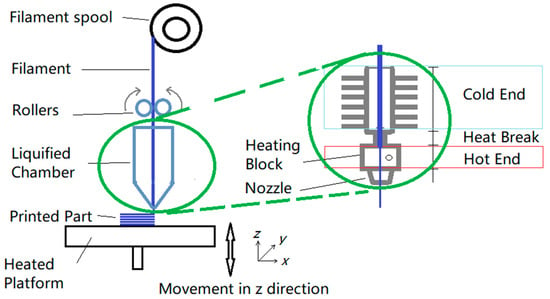
Figure 1.
Schematic of MEX-TRB/P 3D printer, the details of the liquified chamber are enlarged in the closed-up view.
The process of model fabrication begins by feeding filament material through a liquified chamber. A pinch roller mechanism consisting of a set of grooved or toothed rollers grips the filament, and a stepper motor connected to one of the rollers provides energy to pull the filament from a filament spool and push the filament through the liquefied chamber using friction [20].
2.2. Extrusion System
Extrusion systems in MEX-TRB/P printers can be categorized into two types, which are known as the direct-drive system and the Bowden system, as shown in Figure 2. These two types of extrusion systems have been developed to cater to a wider range of materials. In direct-drive extrusion systems, the extruder and hot end are mounted together, keeping the distance between the driving force and the nozzle minimal. Direct-drive systems can process elastic materials because the shorter distance between the driving mechanism and the hot end minimizes compression and eliminates flexion [24]. However, direct-drive systems tend to operate at the same lower printing speeds as the extruder, which is very heavy and moves together with the hot end. The high-speed movement causes vibration, which reduces the overall precision and accuracy of the printed parts. On the other hand, the Bowden extrusion system separates the pinch-roller feed mechanism from the hot end, and the filament is pushed into the hot-end through a Bowden tube system, as shown in Figure 2. The main drawback of Bowden extrusion systems is the difficulty in maintaining constant pressure on the nozzle to ensure proper extrusion. This is mainly caused by the flexion of materials in the tube due to the long distance between the driving mechanism and the nozzle. In addition, friction in the Bowden tube and the compression of the filament [25,26] also contribute to this issue.
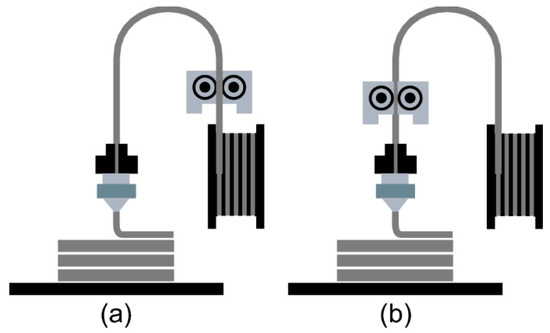
Figure 2.
Bowden extrusion system (a) and direct extrusion system (b) [24].
Downstream of the extrusion system is a liquefier, consisting of a nozzle connected to the heating block. Heat is transmitted to the heating block by a heater cartridge. A thermistor is used to monitor the temperature of that block. The liquefier heats the filament material into a semi-molten state, typically between the glass transition temperature and the melting point [27], and molten filament is extruded through the nozzle and deposited systematically onto a build platform based on the computer-generated file. Once the molten material is deposited, it forms interlamellar bonds with adjacent and preceding filaments as it cools down and solidifies to form a layer [28]. The technology follows a sequential layer-by-layer process, where material is deposited in an X–Y plane according to the geometry of the model. Once a layer is complete, the build platform moves up or down vertically, and a new layer is built upon the previous layer until the 3D model is formed.
2.3. Application and Current Development
The range of applications of conventional extrusion-based systems is limited by the material available, as they are normally thermoplastic parts. However, they are still widely used in industrial applications due to their ability to produce specific parts that are especially useful for prototyping. The aerospace and automotive industry uses MEX-TRB/P systems to manufacture prototypes for aircraft, missiles, and aerofoils utilized for wind tunnel testing. The development of advanced materials such as PEEK with its exceptional material properties offering high strength, stiffness, and ductility, makes it suitable for replacing certain steel and aluminum components in structural applications. This improves the strength-to-weight ratio and aids in reducing overall cost and material wastage. Bio-compatible and bio-degradable polymers have also been developed, allowing products fabricated by this process to be safely used in the biomedical industry and for food packaging.
The anisotropic properties of MEX-TRB/P-printed parts remain a challenge. Composite extruder systems, as shown in Figure 3, have been developed by Anisoprint to improve the physical properties of MEX-TRB/P-printed parts. A reinforcing technique, able to generate fiber-reinforced parts, feeds reinforcing fiber and plastic separately through the same nozzle, resulting in a final product of composite material where the fiber volume ratio can be varied [29]. The continuous basalt fiber co-extruded PA composite (CBFCC) manufactured by this method showed better tensile properties and elastic properties than the neat CFC-PA in longitudinal direction but not the transverse and shear properties. This is because CBFCC has an anisotropy behavior [30]. A different fiber reinforcement technique, employing the double extruder system has also been developed to allow strategic placement of continuous fibers [31]. Continuous glass, carbon, and Kevlar fibers reinforced Nylon composites manufactured by this method showed better tensile and flexural strengths than the pure Nylon [32] but an excessive amount of fibers caused weak bonding between the fiber/matrix.
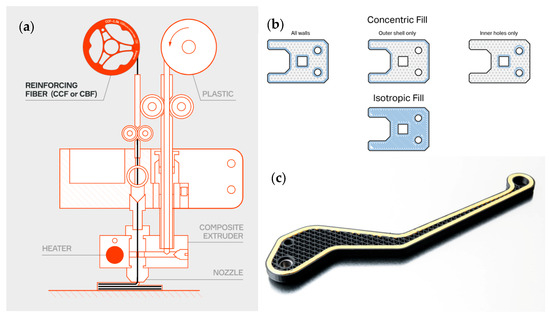
Figure 3.
(a) Composite extruder system. Source: Anisoprint [29]. (b) Fiber fill options. (c) Brake lever with reinforced Kevlar. Source: markforged [31].
2.4. Materials in MEX-TRB/P 3D Printing
Various thermoplastic materials are commonly used as the filaments for MEX-TRB/P 3D printing. The common materials with the proposed extrusion temperature, benefits, and drawbacks are presented in Table 1.

Table 1.
Common materials for MEX-TRB/P 3D printing.
3. Processing Parameters in MEX-TRB/P 3D Printing
In MEX-TRB/P 3D printing, process parameters have a significant influence on the mechanical properties of the fabricated parts. The mechanical properties are dependent on the microstructure and bonding quality between layers. Optimizing the process parameters is able to improve the mechanical properties of the MEX-TRB/P-printed parts. However, it should be noted that the process parameters are highly interrelated and achieving the ideal combination of parameters is very challenging. Most research conducted is limited to a specific set of process parameters relevant to the study and how they affect the mechanical properties of MEX-TRB/P-fabricated parts. Therefore, it is very difficult to develop a general relationship between process parameters based on previous studies, as there are too many variables. Figure 4 shows the process parameters that can be varied in MEX-TRB/P processes, reclassified into three groups:
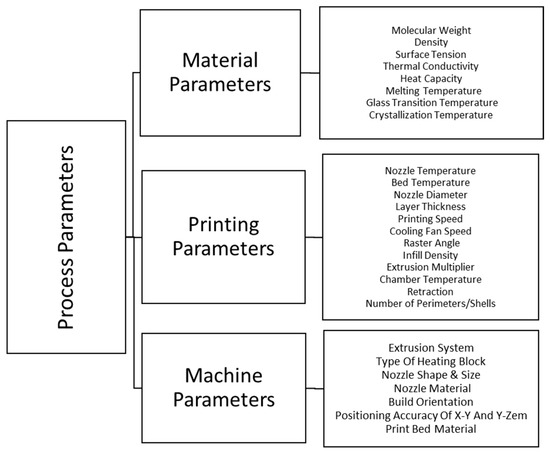
Figure 4.
Summary of parameters that influence the mechanical properties of MEX-TRB/P-fabricated part.
As there is a wide range of thermoplastic material that can be used with MEX-TRB/P, selecting the optimum process parameters for printing helps to improve the quality of the MEX-TRB/P-printed parts. However, certain parameters have a significant effect on the bonding quality and strength of the fabricated parts [43]. Table 2 further explains the temperature-sensitive printing parameters of MEX-TRB/P.

Table 2.
Temperature-sensitive printing parameters for the MEX-TRB/P process.
As mentioned in Section 2.1, the core principle of MEX-TRB/P is derived from the extrusion process. Therefore, the quality of the fabricated parts is highly dependent on temperature-sensitive parameters. Varying these process parameters can yield wide variations in results, even when the parts are fabricated using the same material. Most research investigates the role of printing parameters on mechanical properties. Printing parameters that are commonly investigated are extrusion temperature, bed temperature, printing speed, nozzle diameter, layer thickness, raster angle, infill density, and build orientation [44,45,46,47,48,49,50].
3.1. Temperature Sensitive Parameters
The temperature sensitive parameters can be further categorized into adjustable/controllable parameters and non-controllable parameters, as shown in Figure 5. The influence of temperature sensitive parameters is widely studied by researchers to determine their impact on the mechanical properties of the fabricated parts. The influence of these parameters is studied through the evaluation of different mechanical properties (i.e., tensile, bending, or impact) with the focus on improving the mechanical behavior of the fabricated parts, which is discussed below. The mechanical properties of MEX-TRB/P-fabricated parts are tested based on standards regulated by the American Society for Testing and Materials (ASTM) and International Organization for Standardization (ISO) [51]. Special-shaped test specimens are fabricated based on the guidelines provided, depending on the type of mechanical testing. The specimens will then be subjected to testing based on the standard procedures until failure occurs in the form of rupture or fracture. It should be noted that there are no specific standards for AM-fabricated parts, and the testing procedures are based on standard plastic parts. It should be noted that the results obtained from previous studies were conducted by considering certain parameters, while others are kept constant and therefore should not be compared equally.
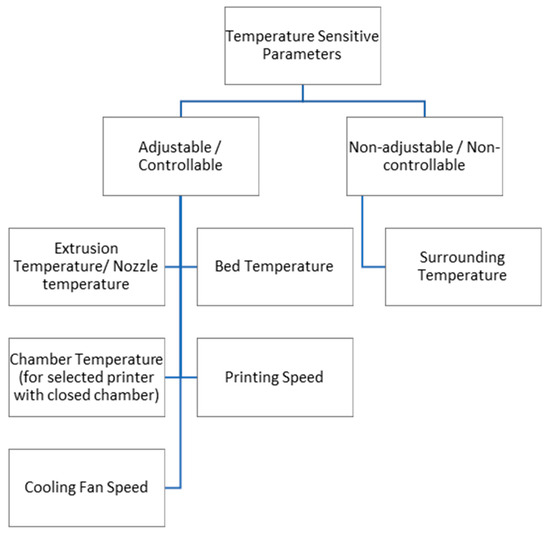
Figure 5.
Adjustable and non-adjustable temperature sensitive parameters in MEX-TRB/P 3D printing.
3.1.1. Nozzle Temperature
The nozzle temperature or the extrusion temperature in MEX-TRB/P is actually the temperature measured at the heating block. The temperature sensor or the thermistor is typically embedded in the heater block (also called the hot end). The heat is transferred into the nozzle and then the filament. The displayed “nozzle temperature” on the 3D printer is actually the temperature of the heater block, which is assumed to be very close to the temperature at the nozzle tip, which filament material is extruded. The actual temperature at the nozzle tip is always lower than the temperature of the heater block, but the exact difference depends on geometry of the hot end and nozzle. Since different printers have different nozzle designs and nozzle geometry, the actual temperature at the nozzle tip varies across different printer models and brand even though the same nozzle temperature was set. As such some inconsistency in results were reported by the previous literature.
A proper selection of nozzle temperature can have a significant effect on the mechanical properties, as the fusion of materials is dependent on the heating and cooling process. The formation of bonds between existing layers and newly deposited layers takes place as extruded material leaves the nozzle and cools down to its glass transition temperature. The mechanical properties of the fabricated parts depend on the quality of bonds formed between extruded filament material. Researchers found that an increase in extrusion temperature has a positive effect on the mechanical properties of the fabricated parts, but an excessive increase might lead to a more brittle part [50,52,53,54]. Studies conducted on PLA material by Alafaghani et al. [55] and Benwood et al. [54] found that the maximum strength for the material is observed at around 200 °C to 220 °C and concluded that the extrusion temperature–strength relationship is not linear. The presence of voids was also extensively studied to investigate the bonds formed between the extruded PLA filaments [56]. It was found that the size and percentage area of voids of MEX-TRB/P printed carbon fiber reinforced ABS decreased as the extrusion temperature increased. After a certain temperature, however, the change becomes less significant even as the temperature was increased further [57]. In addition, it was also observed that excessively high temperatures have a negative effect on the mechanical properties of the printed parts [58]. This is likely due to the rheological property of the material, where it loses viscosity, resulting in the formation of constant voids within the material. Furthermore, high temperatures also caused the material degradation [59]. Therefore, based on past research, the optimization of printing temperature is an important attributing factor on the mechanical properties of MEX-TRB/P-fabricated parts. Similar observation was reported by Rivera-López et al. where they investigated how MEX-TRB/P nozzle temperature affects the mechanical properties of PLA specimens printed from 180 to 260 °C [53]. They found that lower temperatures can reduce material flow and density, negatively impacting mechanical properties. On the other hand, printing temperatures up to 260 °C do not significantly deteriorate mechanical properties despite excess material deposition. An optimal extruder temperature range of 220–240 °C was recommended for balancing mechanical performance and stability in printed specimens. Vanaei et al. [60] studied the effect of extrusion and platform temperature as well as the cooling factors that affect the bonding between PLA materials and concluded that the effect of extruder temperature is more significant compared to other process parameters. While most of the research focused on tensile, impact, or flexural properties, the fatigue behavior of 3D-printed carbon fiber reinforced PLA (CF-PLA) component was investigated by Pandeyel et al. [61]. They investigated the fatigue and impact behavior of CF-PLA composites printed at 225 °C and 240 °C. The CF-PLA specimens printed at 240 °C exhibited a significantly longer fatigue life, almost 2.7 times greater than those printed at 225 °C. Additionally, the average impact strength of the higher-temperature specimens was 3.75 kJ/m2, marking a 5.93% increase compared to those printed at the lower temperature. Optical microscopy analysis revealed better material diffusion and fusion of ridges and pores at 240 °C, leading to fewer voids. These structural improvements contributed to the increases in both fatigue life and impact strength of the MEX-TRB/P 3D printed CF-PLA.
3.1.2. Platform Temperature
The platform temperature in MEX-TRB/P processes acts as a support temperature to reduce thermal stress caused by the rapid cooling of the material. This process parameter is commonly adjusted to reduce residual thermal stress, which induces warping, cracking, and delamination of layers, as shown in Figure 6. It was later discovered that increasing the support temperature can have a positive effect on the mechanical properties of the parts if controlled correctly. A study by Wang et al. [12] reported that increasing the platform temperature enhanced the tensile and flexural properties of MEX-TRB/P 3D-printed PEEK, short carbon fiber-reinforced PEEK and short glass fiber-reinforced PEEK, printed in flat orientation (XY direction). Micrographs from SEM imaging showed that the void spaces became smaller when platform temperature increases, suggesting good interlayer fusion. On the other hand, Chadha et al. [62] reported that an increase in tensile and flexural strength of a MEX-TRB/P-printed PLA specimen was first observed, followed by a decrease when the platform temperature increased, similar to observations for increasing extrusion temperatures. However, the printing orientation was not reported. Thumsorn et al. [63] investigated the rheological behavior of PLA when different platform temperatures were used. Their samples were printed in the XZ direction. The results showed that increasing the platform temperature enhances crystallinity, interfacial interaction, and the degree of entanglement, which promoted stiffness leading to improved flexural and tensile properties.
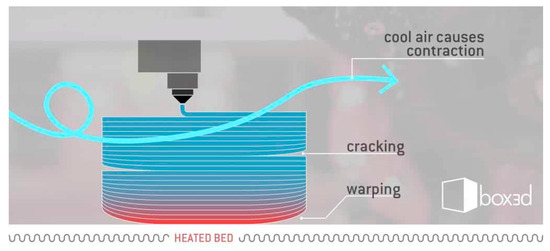
Figure 6.
Warping and cracking in MEX-TRB/P. Source: box3d [64].
3.1.3. Surrounding Temperature, Chamber Temperature, and Cooling Fan Speed
As mentioned above, the bonding process in MEX-TRB/P depends on the heating and cooling of the material. The role of extrusion temperature and platform temperature, which provide heat energy, have been discussed in the sections above. On the other hand, the cooling of the material can be induced mechanically through the cooling fan and by convection to the ambient surroundings. Giri et al. [65] reported a slight decrease in tensile strength of MEX-TRB/P printed PLA when the fan speed varied from 25%, 50%, 75%, and 100%. Lee et al. [66] designed and installed a forced air-cooling system on a commercial 3D FFF printer to study the effects of cooling on the dimensional accuracy and mechanical properties of the fabricated PLA parts. A higher airflow velocity improved the dimensional quality but decreased the mechanical strength. The weaker mechanical properties were attributed to the increased void within the internal cavity of the parts, as well as lower crystallinity of the solidified PLA. However, Portoacă et al. [48] revealed that a temperature of 180 °C and 80% fan speed maximized tensile strength, modulus, and elongation while minimizing energy usage for PLA samples. They optimized the energy consumption in MEX-TRB/P 3D printing by analyzing printing parameters (fan speeds of 60%, 80%, and 100%; printing temperature 170 to 190 °C) and they found out that the fan speed is a key factor for UTS and elongation at break.
Thumsorn et al. [67] investigated the effects of ambient temperature and crystalline structure on the interlayer adhesion and fracture toughness of MEX-TRB/P-printed PLA. It was reported that the fracture toughness increases with a higher chamber temperature, likely due to the reorientation of polymers into their crystallized form. The increased chain mobility induces molecular diffusion and molecular entanglement, improving the interlayer adhesion between layers. The correlation of printing temperature, crystallinity, and tensile of MEX-TRB/P-printed PLA was reported by Portoacă et al. [48]. They found that the degree of crystallinity decreased with the increasing printing temperature and cooling rate, while a higher degree of crystallinity generally led to an increase in Young’s modulus.
3.1.4. Printing Speed
The production rate of MEX-TRB/P-fabricated parts remains a challenge for this technology. In addition to increasing the layer thickness to reduce the number of layers required, increasing the print speed is also a common parameter optimized to increase production rate. Therefore, this process parameter is also widely studied to determine its effects on the fabricated part. Chalgham et al. [68] discovered that increasing the printing speed from 30 mm/s to 90 mm/s can reduce the production time by approximately 30%. However, it was suggested to use a lower printing speed due to strong variations in the deflection at break, although a similar maximum force was recorded. On the other hand, Muthu et al. [69] studied the effect of printing speed and layer thickness on the mechanical properties together. The results showed that increasing printing speed reduced both the tensile and flexural properties while not significantly affecting the impact strength. Saravana Kumar et al. [49] reported that increasing the printing speed and temperature led to a reduction in flexural strength of the MEX-TRB/P 3D-printed PLA specimens. This was due to the lack of sufficient time for proper interlayer bonding. Furthermore, the higher printing speed (70 mm/s) also causes more porosity and fracture formation, resulting in poor bending strength.
A numerical model produced by Daly et al. [70] also observed that increasing the printing speed resulted in weaker tensile strength of MEX-TRB/P-printed ABS. However, the study showed that less residual stress and deflection can be achieved by increasing print speed. This is important, as residual stress can lead to the development of cracks in the material and delamination between layers of the printed part. The effect of layer thickness was also investigated, and its contribution to cooling, with results show that a reduction in layer thickness contributed to better tensile behavior and improved mechanical properties [71,72,73], except for Ahn et al., who suggested otherwise [74].
4. Temperature and Interlayer Bond Strength
It is well known that MEX-TRB/P-printed parts exhibit anisotropic mechanical properties and are weaker compared to their injection-molded counterparts. This is inevitable due to the weak interfacial bonding between deposited layers, which is a result of the sequential deposition process. In addition, the development of voids between deposited filaments is also a factor that results in weak mechanical properties. The operation of MEX-TRB/P printers depends on the melting and extrusion of polymeric material, which is similar to the extrusion-based technologies. During printing, the extruded material quickly cools to the surrounding temperature once it leaves the nozzle. This affects the bonding quality between filaments. Therefore, cooling is an important parameter that should not be neglected. Adverse effects of not using the optimum temperature-sensitive process parameters can result in the development of residual thermal stress, which is the main cause of cracking, delamination, and warping.
Hence, the development of temperature profiles during the printing process is a widely studied area, as it can help to understand how heat is distributed and consequently affects the development of bonds in MEX-TRB/P-fabricated parts. Studies have been conducted by measuring the temperature profile of the printing process using a combination of thermal camera and sensors [75]. Research has also been conducted to simulate the temperature profile and compare it with results from experimental measurements before relating them to the bonding quality of the deposited filaments [76]. Most research that has been conducted focuses on the influence of temperature-sensitive parameters with regard to bonding quality but not on the changes in material chemistry at different temperatures. Thumsorn et al. [67] extensively studied the effects of crystalline structure on interlayer adhesion and concluded that higher crystallinity increased molecular entanglement between printed PLA layers, resulting in improved interlayer adhesion. This section explores the influence of temperature on the development of bonds as well as material chemistry and their relationship to the mechanical properties of MEX-TRB/P-fabricated parts.
4.1. Influence of Temperature on Bonding Quality
As the deposition of semi-molten filament operates on a layer-by-layer basis, the adhesion between adjacent and preceding filament greatly affects the mechanical properties of MEX-TRB/P-printed parts. The bonds formed between deposited filament material can be categorized into intra-layer and inter-layer bonding, as shown in Figure 7. Intra-layer bonding refers to bonds formed between adjacent filaments within the same layer, while inter-layer bonding refers to bonds formed between two successive layers [77].
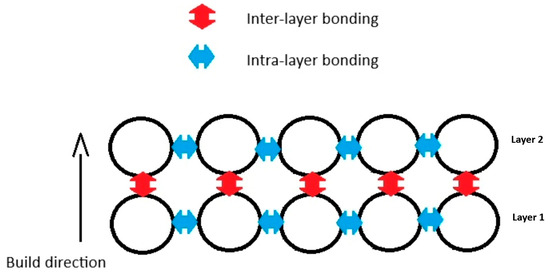
Figure 7.
Inter- and intra-layer bonding in MEX-TRB/P. Reconstructed based on: [77].
The strength of bonds is dictated by the diffusion bonding of polymer chains across their surrounding interface. The motion of chains and interaction across the interface during deposition of semi-molten filament can be presented in five distinct stages, illustrated in Figure 8 [78].

Figure 8.
Model showing (1) surface rearrangement, (2) surface approach, (3) wetting, (4) diffusion, and (5) randomization. Source: [78].
As illustrated in Figure 9, the model was further simplified into three stages of bond formation: surface contacting, neck growth, and molecular diffusion at the interface and randomization in research by Sun et al. [79] to determine the effect of processing conditions on the bonding quality of MEX-TRB/P polymer filaments.

Figure 9.
Formation of neck between filaments [80].
When a stream of semi-molten filament material is extruded next to an existing filament, viscous flow of the polymer causes neck formation as they are in molten state. Molecular diffusion at the interface and randomization can be explained using the reptation theory, and the time required for diffusion and randomization can be approximated by the reptation time of the polymer chain [77]. Similar to any other heated material, cooling will occur once the material exits the heating zone, which in this case is the nozzle. The rate of heat dissipation depends on the temperature difference between the material and its surroundings, which affects the time available for crystallization to occur [78,81,82]. Heat conduction is the main mode of heat transfer to fuse the layers together. On the other hand, convection and radiation drive the flow of heat from the deposited filament to the surrounding environment. Therefore, it is important to investigate the thermal behavior within the deposited material and the exchange of heat with the surroundings to determine how these factors influence the mechanical properties of the printed parts [78,83].
A limitation in MEX-TRB/P printing is the presence of a time interval between deposition of the current layer and previous layer, which results in the cooling of the previously deposited layer. The effect of cooling between successive layers was studied by Morales et al. [84], where they printed the 0.5 in (12.7 mm) diameter and 1.0 in (25.4 mm) tall cylindrical ABS samples with a printing speed of 3600 mm/min. The results showed a 25% reduction in compressive and shear strength when the wait time (interval between layers) was increased from 0 to 20 s. The results were in line with a separate study, where the time interval in between consecutive PLA layers was reduced by increasing the printing speed, and DSC results showed a higher degree of crystallinity at higher printing speed [85]. In larger parts, the previously deposited filament would have cooled down before the next filament is deposited, leading to poor adhesion between adjacent and preceding filaments. The weak adhesion strength is caused by the poor bonding quality and formation of void spaces, leading to weaker mechanical properties of the fabricated part and, in serious cases, causing delamination [86].
Vanaei et al. [85] studied the possibility of increasing the printing temperature to reheat the previous PLA layer. Findings concluded that inter-filament bonding was stronger when the deposition temperature of current filament on the preceding filament occurred at temperatures greater than or equal to the polymer crystallization temperature [85]. However, this study was conducted based on the extrusion of a single strand of filament deposited on top of each other, which only considers heat transfer to preceding filament (two-dimensional) [87]. The model can be further expanded to include heat transfer to adjacent filaments (three-dimensional). Increasing the print temperature showed its ability to reheat the previously deposited filament and develop better bonding but more research needs to be conducted to investigate this phenomenon in the presence of adjacent filaments. It should also be noted that an excessively high printing temperature will result in the reduction in dimensional accuracy of the printed parts [52,54,55].
4.2. Influence of Temperature on Material Properties
Temperature and Crystallinity of a Polymer
As the manufacturing industry moves towards utilizing more environmentally friendly materials, increasing attention has been given to bio-based plastics. However, bio-based plastics are known to have inferior properties compared to traditional petroleum-based plastics [88]. The dominant arrangement of chains is tied to thermal conditioning, which depends on the amount of energy available. At higher temperatures, the amount of energy available will be higher, allowing the chains to move into their desired state more freely [89]. Thermoplastic polymers mostly exist in two forms, which are amorphous and semi-crystalline, as illustrated in Figure 10 [90]. In semi-crystalline polymer, the degree of crystallinity is quantified as the amount of crystalline structure present in the form of a percentage, while the remainder is in an amorphous state. The degree of crystallinity generally ranges between 10% and 80% for most polymers. For easier understanding, the higher the degree of crystallinity of a polymer, the higher the percentage of molecular chains in the crystallized form.
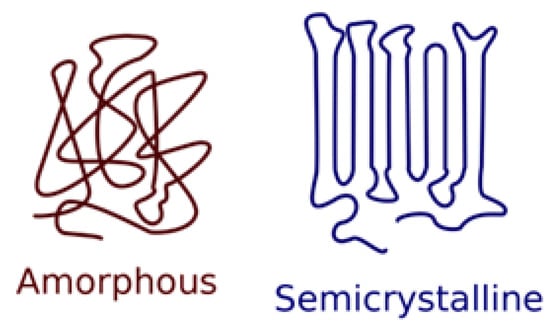
Figure 10.
Arrangement of molecular chain in different forms for semi-crystalline polymers [90].
Ma et al. [91] studied the effect of crystallization on the mechanical and heat resistance performances of PLA. The results revealed that crystallization is beneficial to the heat resistance of the material but resulted in weaker mechanical properties. When the amorphous regions are allowed to rearrange into crystalline regions, the number of PLA macromolecular chains for enduring stress increases, and fewer chains contribute to the strain. Therefore, the Young’s modulus increases, and the elongation at break decreases, which indirectly leads to a decrease in tensile strength.
The primary bonding mechanism between separate polymer chains is dominated by relatively weak van der Waals forces [92]. As these forces depend on short-range interactions, stronger interactions are formed when the polymers are packed together tightly in their crystallized form. PLA is known to have a slow crystallization time, i.e., the polymer would need to be cooled slowly to allow adequate time for recrystallization to occur [93]. If the cooling process is rapid, the majority of the polymer chains will remain in the amorphous arrangement. Therefore, the interactions are weaker as they are further apart compared to their arrangement in the crystallized form [94,95]. The degree of crystallinity for a polymer has a very profound effect on the melting temperature, as the bonds present are very regular [96]. Therefore, the amount of energy required to break the bond is the same. A highly crystalline polymer will remain in the solid phase until it reaches a certain temperature. Sufficient energy needs to be provided to break the bonds before the material transitions into the molten state [97].
On the other hand, amorphous polymers will not have an exact melting temperature. Instead, their softening occurs across a wide range of temperatures. Across this range, the material becomes soft, viscous, and eventually turns into a liquid. This range of temperature is known as the glass-transition temperature [98]. Annealing the sample around its glass-transition temperature will allow extra time for the semi-crystalline PLA to rearrange into its more crystallized form, thus increasing its strength [95,99,100]. There is no clear division between amorphous and crystalline polymers and most polymers exist in a mixture of crystalline and amorphous regions, and these proportions can be measured using percentages. This adds to the importance of the temperature history of the material, as it will determine the degree of crystallinity of the polymer [101].
Below are the factors affecting the glass transition temperature of a polymer [102]:
- Molecular Weight—An increase in molecular weight will lead to a decrease in chain concentration. This decreases the free volume at the end group region, causing an increase in glass transition temperature.
- Molecular Structure—The presence bulky, inflexible side group increases the glass transition temperature of material compared to straight chains.
- Chemical Cross-linking—Cross-linking decreases the mobility of chains, which leads to a decrease in free volume and increases the glass transition temperature.
- Polar Groups—The presence of polar groups increases the intermolecular forces. This increases the inter-chain attraction and cohesion, which leads to a decrease in free volume, resulting in a higher glass transition temperature.
The above-mentioned properties are all related to the material properties of polymers, particularly the crystallization kinetics of polymers. On the other hand, the adhesion strength between layers of deposited filament is the ‘Inter- and intra-layer’ strength.
4.3. Relationship Between Material Properties and Bonding Quality
The mechanical properties of polymer materials are affected by their thermal history and external forces, which depend on the processing method used. For example, high pressure is exerted on polymer melts during injection molding, producing articles with high compaction and homogenous structures [103]. On the contrary, MEX-TRB/P processes rely on the bonding of polymer melts to form welds with neighboring material without external forces apart from gravity [79]. As a result, the adhesion quality between the interfaces will have a strong influence on the structural integrity and mechanical properties of the fabricated parts. As shown in Figure 9, successful bonding between filaments involves three processes: surface contact, neck growth, and inter-layer neck formation. The interfacial bond strength increases with weld time above the glass transition temperature of the polymer under isothermal conditions. However, the layer-wise deposition of the MEX-TRB/P process leads to non-isothermal conditions when bonds are formed, and the equivalent time for bonding is very short [104]. Research has been conducted to analyze bond formation using modeling and experiments. Constructing the temperature model profile by utilizing different temperature measurement devices can verify the accuracy of the results generated through modeling.
Based on the literature above, the coalescence temperature at which filament bonding occurs will affect both the crystallization of the polymer and the intra/inter layer bonding strength. However, the coalescence temperature is highly dependent on the process parameters, particularly those that affect the heating and cooling of the filament material during printing. Therefore, a combination of numerical and experimental methods is commonly used to obtain an accurate temperature profile in order to analyze how coalescence temperature affects the mechanical properties of the fabricated parts.
4.4. Temperature Evolution in MEX-TRB/P Process
The coalescence temperature, at which the formation of bonds materialize, is difficult to accurately measure, as it results from a combination from heat gained and lost during the printing process. Therefore, there has been increasing interest in utilizing numerical and experimental methods to predict the coalescence temperature at which bonding occurs by including cooling effects. The heat transfer mechanisms present in MEX-TRB/P process can be sub-divided into heat gain and heat losses, as shown in Figure 11, where the labels (a)–(e) represent the heat transfer model in Figure 12.
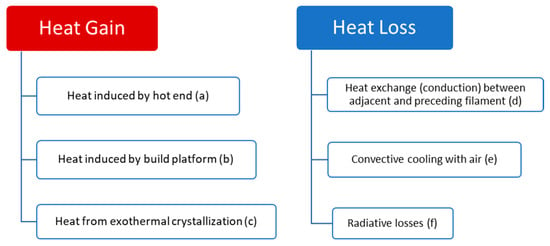
Figure 11.
Heat transfer mechanisms in the MEX-TRB/P process.
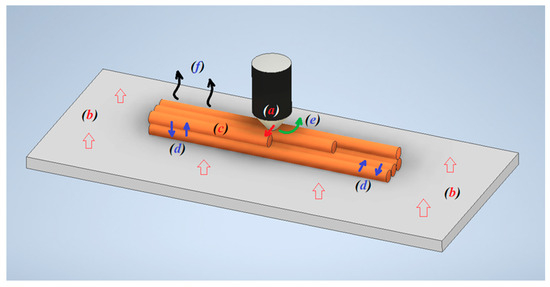
Figure 12.
Heat transfer mechanisms in MEX-TRB/P. Reconstructed based on [105].
The quality of bonds formed between layers determines the mechanical properties of the parts, and improper bonding can become a point of failure in the fabricated parts. This is dictated by heat transfer during the printing process; therefore, the concept of heat transfer has been studied over the years since MEX-TRB/P 3D printing was invented. Figure 12 shows the heat transfer mechanisms in MEX-TRB/P. For heat gain, the heat induced by hot end (a) provides heat energy to melt the material, heat induced by the build platform (b) provides a support temperature for the material, while heat from exothermal crystallization (c) is induced during the rearrangement of molecular chains [105]. The released heat during exothermal crystallization depends on the material, with temperature increases of less than 1 °C for Technomelt PA 6910 and up to 6.3 °C for PA 6/66 due to the enthalpy of crystallization [106]. Heat is mainly lost by conduction as the material is deposited (d), convective cooling with air once it is deposited (e), and radiative losses to the surroundings (f) [105].
According to Vanaei et al. [87], there is a reheating effect when the hot filament comes into contact with the previously deposited filament. It was mentioned that the reheating effect improves the bonding quality between adjacent and preceding filaments, particularly when the reheating temperature is above the glass transition temperature, Tg for amorphous materials. For semi-crystalline materials, the molecular chain re-arrangement occurs around the crystallization temperature, Tc and the thermoplastic material rearranges into a more crystallized form. Therefore, a higher printing temperature would result in a more profound reheating effect on the previously deposited filament, allowing molecular rearrangement, but it should not be too high to prevent excessive deformation.
5. Experimental and Numerical Studies of Thermal Behavior in MEX-TRB/P
The temperature evolution during the printing process is important as it dictates the quality of bonding. A comparison of numerical solutions with actual experiments is needed to authenticate and enhance the developed heat transfer model. Experimental studies conducted based on in-process monitoring of temperature profiles during the printing process can be divided into two classifications, which are global temperature recording and local temperature recording. However, experimental studies are often limited by the sensitivity of the equipment, and these measurements do not fully depict the heat transfer process. Therefore, the preferred method is often a combination of both experimental and numerical results because the comparison can help obtain a more accurate temperature profile as well as the representation of how heat is transferred during the printing process. Table 3 outlines past research that has been conducted to study the temperature evolution during MEX-TRB/P 3D printing.

Table 3.
Summary of research on the influence of printing temperature.
5.1. Global Temperature Measurement on External Surface of Layers
Infrared thermal cameras are the most important and widely used technique to monitor the global temperature profile and its changes in the MEX-TRB/P deposition process. In a study by Seppala et al. [113], infrared thermography was utilized to map the temperature profile under different printing conditions and observed an increase in weld strength with increasing weld time. The study focused on the weld zone to provide an estimation of the sub-layer heating and its effect on weld formation [114], as shown in Figure 13.
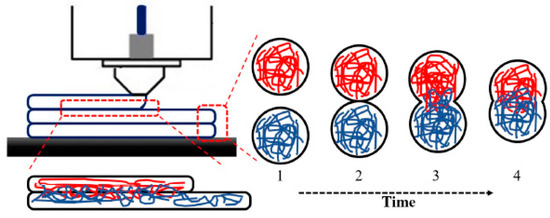
Figure 13.
Schematic representation of material deposition and bond development. Blue represents layer 1 and red represents layer 2. Source: [115].
Due to the limited depth-of-field of infrared cameras, the majority of the studies conducted are 2D, where the temperature monitoring is performed on a vertical wall. Ferraris et al. [111] recorded temperature variations with respect to time during printing of PLA parts, to construct a thermogram, as shown in Figure 14a, and compared it with the results from the finite difference method. Lepoivre et al. [105] employed both numerical and experimental procedures by using an infrared camera to record the temperature of a MEX-TRB/P-printed polyetherketoneketone or ABS vertical walls, as shown in Figure 14b, and solved the heat transfer model using COMSOL (Figure 14c). The results showed good agreement between the experimental temperature measurements and the numerically predicted results. Kuznetsov et al. [116] conducted a series of experiments by utilizing a FLIR thermal camera to obtain thermograms of the printing process, as shown in Figure 14d. The effects of different process parameters on mechanical properties of MEX-TRB/P-fabricated PLA parts were studied based on a 3D-model, and the results were related to the temperature evolution during the printing process.
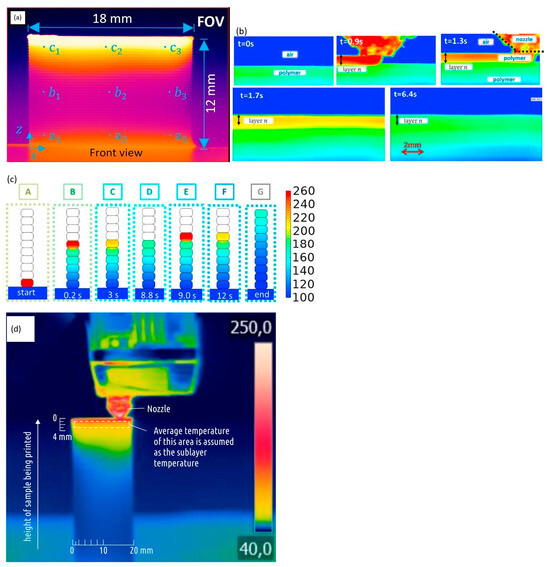
Figure 14.
(a) Thermograms of printed parts. Source: [111]. (b,c) IR camera analysis and COMSOL model. Source: [105]. (d) Temperature distribution in samples printing at different extrusion temperature. Source: [116].
5.2. Local Temperature Measurement at Bond Interface
Utilizing an IR thermal camera allows for temperature measurement on the surface of the filaments during the printing process but not the local temperature at the interface where the filament is deposited. Local temperature measurements at locations where the filament is deposited are used to record the actual temperature where bonding occurs (coalescence temperature). Apart from recording the temperature at the interface, local temperature recording can also track the cooling and reheating effect when a new layer is deposited on the preceding layers. Yin et al. [109] measured the temperature evolution during MEX-TRB/P by embedding K-type thermocouples into the polyurethane (TPU)/acrylonitrile butadiene styrene (ABS) bi-material layers to study the interfacial temperature profiles. The results were validated using a 3D transient heat transfer model and showed good agreement. Xu et al. [112] constructed a thin wall and embedded T-type thermocouples to analyze the temperature evolution during the ABS fabrication process. The results were compared with numerical simulation and showed good agreement. However, the main drawback of using local temperature measurement devices is the disruption of the print process due to the placement of thermocouples. Some researchers utilize micro K-type thermocouple (d = 80 µm) to measure the temperature variation without pausing the process to minimize the disruption and further enhance the accuracy of the results [87].
5.3. Numerical Studies
Due to the difficulty of temperature measurement during MEX-TRB/P printing process, several numerical studies have been conducted to supplement the experimental methods. Since direct temperature measurement can be challenging, these numerical studies provide additional information by offering valuable insights and analysis of temperature-related phenomena in MEX-TRB/P printing. The cooling of filament due to convection with the environment was first modeled by Yardimici et al. [117] to study the effect of different building strategies [118]. Rodriguez et al. [119] developed the wetting-diffusion model to predict bonding based on the reptation theory and concluded that a lower cooling rate promoted stronger bonding for ABS [120]. Costa et al. [11] proposed an analytical solution to model the transient heat transfer during the MEX-TRB/P ABS filament deposition process. Their approach considered various process parameters, including extrusion velocity, filament dimensions, material properties, deposition sequence (as shown in Figure 15), and ambient temperature,. The results of their study demonstrated that the temperature evolution was influenced by the contact characteristics between filaments. However, it is important to note that the proposed analytical approach made certain simplifications. It assumed idealized filament geometry, considering cylindrical filaments, and it did not account for the re-heating effects caused by adjacent filaments. With the advancement in computing power, more complex numerical modeling to include the effects of temperature evolution has been made possible. Costa et al. [121] improved their heat transfer model to predict the temperature evolution during printing ABS part. This model considered heat exchanges due to convection and radiation with the environment, conduction with support and between adjacent filaments, radiation between adjacent filaments, and convection with entrapped air. They conducted mechanical deformation analyses of filament clusters, considering both purely elastic and viscoelastic behavior at various temperatures. The study revealed that heat exchanges through convection with the environment and conduction between adjacent filaments and machine support had the most significant impact on the thermal evolution of the cluster. Conversely, heat exchanges through radiation between adjacent filaments and convection with air pockets were found to be minimal. Furthermore, they also reported that the mechanical deformation caused by the weight of the filaments was negligible, suggesting its insignificant influence on heat transfer and the dimensional accuracy of the printed part. Costa et al. [11] further expanded their study by developing an analytical solution for transient heat conduction during filament deposition in MEX-TRB/P. The solution algorithm accounted for the deposition sequence and the degree of adhesion between the most recently deposited filament segment and adjacent segments, considering the evolution of the degree of healing between contacting filaments based on the work of Yang and Pitchumani [122]. The researchers compared the numerical predictions for temperature evolution and adhesion with experimental data obtained through thermography during printing polyether ether ketone and peel tests, respectively. The results demonstrated good agreement between the numerical predictions and experimental observations.
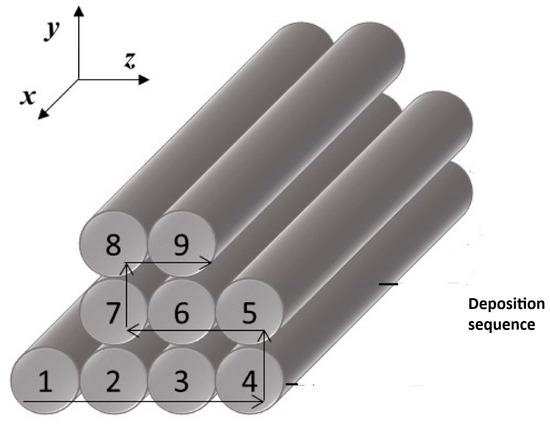
Figure 15.
Filament deposition sequences, the numbers represent the sequence of filament deposition. Source: [11].
Xia et al. [123] extended a finite volume method, which was already capable of simulating multiphase flow problems, to include the injection and cooling down of a polymer. The model was capable of showing the evolution of temperature and bonding quality when different printing speed and nozzle temperatures were used, as shown in Figure 16a. Heat transfer models shown in Figure 16b,e are based on CFD and the finite element method, which were developed to determine the temperature evolution and the reheating effect based on a 2D vertical wall. The simulation showed the temperature development when a new layer of filament is deposited on previous layers, and the effect of different processing parameters was analyzed [124,125]. Zhou et al. showed an approach of voxelization modeling-based finite element simulation, illustrated in Figure 16c. In this approach, the model was first meshed based on voxelization and sorted before undergoing finite element simulation using ANSYS parametric design language (APDL) with the birth and death technique [126]. Key process parameters, such as temperature field, scanning speed, chamber temperature, and nozzle temperature were investigated to determine which had the most significant effect. The benefit of this method is its capability in meshing complex 3D parts, as shown in Figure 16c. Two-dimensional (2D) heat transfer models that have been previously proposed only take into account the heat transfer to preceding layers but not adjacent filaments. Voxelization meshing can be used to simulate actual fabrication models, which are three-dimensional. A summary of research conducted on heat transfer modeling is tabled in Table 4.
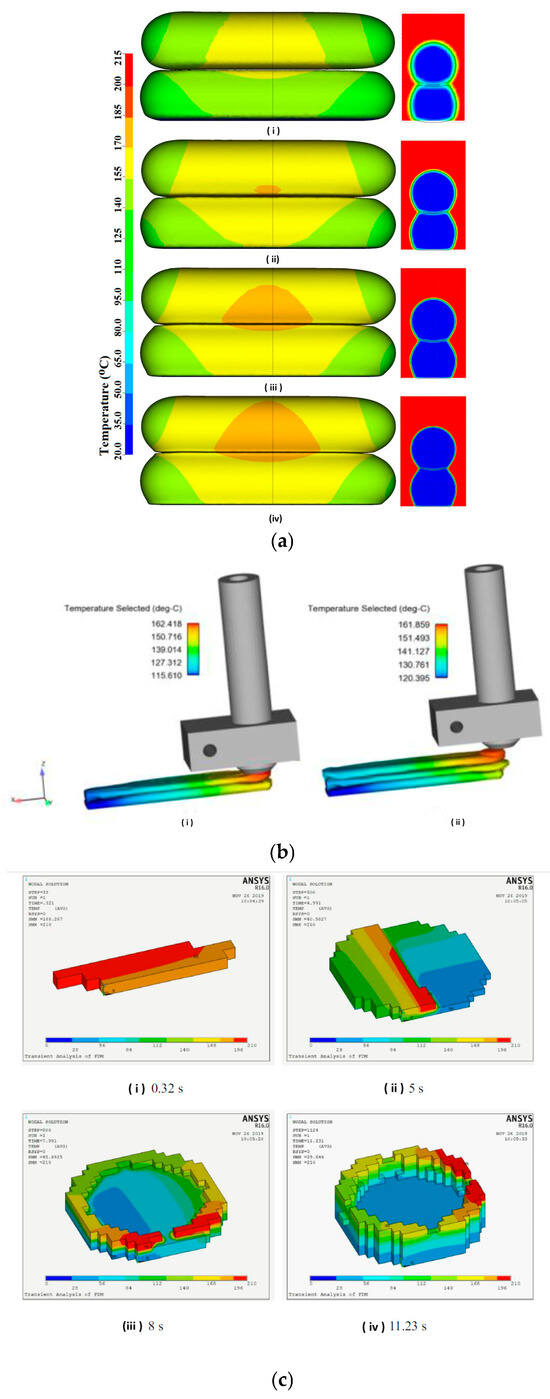
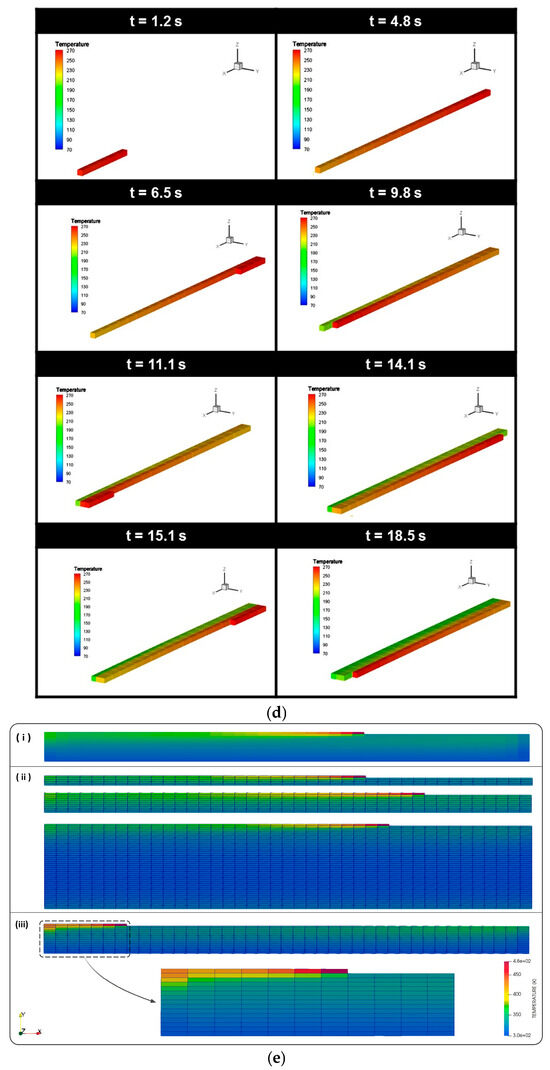
Figure 16.
(a) Filaments deposited on top of each other with different bonding quality. Source: Xia et al. [123]. (b) Thermal distribution of multi-layer PLA using FLOW-3D CFD. Source: Verma et al. [124]. (c) Temperature evolution during print process using voxelization modeling-based FEM. Source: Zhou et al. [126]. (d) Filament temperature at various instants of deposition process using MATLAB. Source: Costa et al. [11]. (e) Temperature distribution of deposition process for vertical wall. Source: Vanaei et al. [125].

Table 4.
Summary of research conducted on heat transfer modeling.
6. Opportunities for Future Developments
Based on the review of recent works above, optimizing temperature-sensitive process parameters can have a huge effect on the mechanical properties of the fabricated parts. This is because of the coalescence temperature, where the formation of bonds changes, affects the development of void spaces within the internal cavity. The formation of void spaces is commonly associated with neck formation and molecular diffusion across interfaces, which affects the overlapping between filaments [132]. Currently, this is studied through image processing techniques utilizing scanning electron microscope images with the aid of image processing software [86]. The main drawback of these techniques is the requirement of a cross section of the fabricated parts, and obtaining these through mechanical cutting is likely to damage the original features. However, this issue can be counteracted by using non-destructive testing methods such as micro computed tomography (micro-CT). In micro-CT, the 3D-part can be scanned, and precise dimension of both internal and external structures can be captured. The results can then be exported in the form of 3D-model and sliced in the software to study the formation of voids within the internal cavity [133]. From the review, it can also be observed that temperature measuring techniques are limited by the sensitivity and field of view of Infrared (IR) cameras, which depend on the position of the IR-camera. Currently, most of the temperature measurement studies are conducted in a two-dimensional manner and are only able to produce temperature profile of a single plane [76]. This can be improved by placing several IR cameras in strategic locations and coupled with video stitching applications, which will be able to produce a 360 degree/panoramic view of the temperature measurements [134]. In addition, the technological advancement in artificial intelligence (AI) and machine learning (ML) has been noteworthy and can be used with video stitching applications to construct a comprehensive 3D temperature model based on the recorded videos [135]. The generated temperature distribution of these 3D temperature models can be especially useful for comparison to further validate the feasibility and accuracy of the numerical models. Based on the numerical models, the optimum temperature-sensitive process parameters can be predicted for different materials.
7. Conclusions
The mechanical properties of MEX-TRB/P-fabricated parts are affected by the selection of a wide variety of process parameters. The core principle of MEX-TRB/P 3D printing is derived from extrusion, which depends on the heating and cooling of materials. This paper presents a comprehensive review on temperature-sensitive process parameters and how they affect the mechanical properties of the fabricated parts. By understanding how these parameters affect the formation of bonds and changes in material properties, optimization can be applied to maximize the full potential of MEX-TRB/P-fabricated parts. Most research that has been conducted studies individual parameters and how they affect the final product. Through this review, it is clear that the effects of process parameters are highly interrelated. By categorizing them into a group of parameters, as in Section 4, the conflicting effects of the parameters on the fabricated parts can be eliminated when optimizing these parameters. In addition, the heat distribution during MEX-TRB/P 3D printing is a complex process. The actual (coalescence) temperature is the determining factor that dictates the quality of bonds formed and is a result of heat gained and heat loss during the deposition process. In MEX-TRB/P, the amount of heat available determines the quality of bonds formed, resulting in changes in mechanical properties. Most materials have an optimum working temperature, where these conditions favor the formation of bonds. In the review, it was noted that an excessively high working temperature results in the reduction in mechanical properties, and this is likely due to the changes in material properties (or material chemistry), which are not widely studied. Next, the development of more efficient numerical models is also highly beneficial, as these can help to further understand the temperature distribution and thermal stresses. This is especially useful for large parts and actual products that require many elements, as most numerical simulations developed currently are limited by computational time and computing power. Lastly, the knowledge and understanding gained from this review aim to help in the development of a framework that can be used to optimize temperature-sensitive processing parameters and applied to actual products.
Author Contributions
Conceptualization, M.K.L. and T.C.Y.; methodology, M.K.L. and R.P.; investigation, R.P.; writing—original draft preparation, R.P.; writing—review and editing, M.K.L., H.H.T. and T.C.Y.; visualization, R.P.; supervision, M.K.L. and T.C.Y.; project administration, M.K.L.; funding acquisition, M.K.L. All authors have read and agreed to the published version of the manuscript.
Funding
This work was supported by the Ministry of Higher Education Malaysia under the Fundamental Research Grant Scheme (FRGS/1/2019/TK05/HWUM/02/2).
Acknowledgments
The authors thank the laboratory staff at the School of Engineering and Physical Sciences at Heriot-Watt University Malaysia for their technical assistance. R.P. would like to thank the Malaysian Ministry of Higher Education (MOHE) and Heriot-Watt University Malaysia for the financial support. M.K.L. would like to thank the funder of this project.
Conflicts of Interest
The authors declare no conflicts of interest. The funders had no role in the design of the study; in the collection, analyses, or interpretation of data; in the writing of the manuscript; or in the decision to publish the results.
References
- Song, Y.; Yan, Y.; Zhang, R.; Xu, D.; Wang, F. Manufacture of the Die of an Automobile Deck Part Based on Rapid Prototyping and Rapid Tooling Technology. J. Mater. Process. Technol. 2002, 120, 237–242. [Google Scholar] [CrossRef]
- Thomas, C.L.; Gaffney, T.M.; Kaza, S.; Lee, C.H. Rapid Prototyping of Large Scale Aerospace Structures. In Proceedings of the IEEE Aerospace Applications Conference Proceedings, Aspen, CO, USA, 10 February 1996; pp. 219–230. [Google Scholar]
- Giannatsis, J.; Dedoussis, V. Additive Fabrication Technologies Applied to Medicine and Health Care: A Review. Int. J. Adv. Manuf. Technol. 2009, 40, 116–127. [Google Scholar] [CrossRef]
- Sachlos, E.; Czernuszka, J.T. Making Tissue Engineering Scaffolds Work. Review: The Application of Solid Freeform Fabrication Technology to the Production of Tissue Engineering Scaffolds. Eur. Cells Mater. 2003, 5, 29–40. [Google Scholar] [CrossRef] [PubMed]
- Bird, D.T.; Ravindra, N.M. Additive Manufacturing of Sensors for Military Monitoring Applications. Polymers 2021, 13, 1455. [Google Scholar] [CrossRef]
- Jagoda, J.; Diggs-McGee, B.; Kreiger, M.; Schuldt, S. The Viability and Simplicity of 3D-Printed Construction: A Military Case Study. Infrastructures 2020, 5, 35. [Google Scholar] [CrossRef]
- History of 3D Printing: When Was 3D Printing Invented? Available online: https://all3dp.com/2/history-of-3d-printing-when-was-3d-printing-invented/ (accessed on 2 October 2022).
- Onuh, S.O.; Yusuf, Y.Y. Rapid Prototyping Technology: Applications and Benefits for Rapid Product Development. J. Intell. Manuf. 1999, 10, 301–311. [Google Scholar] [CrossRef]
- Calignano, F.; Manfredi, D.; Ambrosio, E.P.; Biamino, S.; Lombardi, M.; Atzeni, E.; Salmi, A.; Minetola, P.; Iuliano, L.; Fino, P. Overview on Additive Manufacturing Technologies. Proc. IEEE 2017, 105, 593–612. [Google Scholar] [CrossRef]
- Huang, B.; Meng, S.; He, H.; Jia, Y.; Xu, Y.; Huang, H. Study of Processing Parameters in Fused Deposition Modeling Based on Mechanical Properties of Acrylonitrile-Butadiene-Styrene Filament. Polym. Eng. Sci. 2019, 59, 120–128. [Google Scholar] [CrossRef]
- Costa, S.F.; Duarte, F.M.; Covas, J.A. Estimation of Filament Temperature and Adhesion Development in Fused Deposition Techniques. J. Mater. Process. Technol. 2017, 245, 167–179. [Google Scholar] [CrossRef]
- Wang, P.; Zou, B.; Ding, S.; Li, L.; Huang, C. Effects of FDM-3D Printing Parameters on Mechanical Properties and Microstructure of CF/PEEK and GF/PEEK. Chin. J. Aeronaut. 2021, 34, 236–246. [Google Scholar] [CrossRef]
- Popescu, D.; Zapciu, A.; Amza, C.; Baciu, F.; Marinescu, R. FDM Process Parameters Influence over the Mechanical Properties of Polymer Specimens: A Review. Polym. Test. 2018, 69, 157–166. [Google Scholar] [CrossRef]
- Jaisingh Sheoran, A.; Kumar, H. Fused Deposition Modeling Process Parameters Optimization and Effect on Mechanical Properties and Part Quality: Review and Reflection on Present Research. Mater. Today Proc. 2020, 21, 1659–1672. [Google Scholar] [CrossRef]
- Kamaal, M.; Anas, M.; Rastogi, H.; Bhardwaj, N.; Rahaman, A. Effect of FDM Process Parameters on Mechanical Properties of 3D-Printed Carbon Fibre–PLA Composite. Prog. Addit. Manuf. 2021, 6, 63–69. [Google Scholar] [CrossRef]
- Wu, H.; Fahy, W.P.; Kim, S.; Kim, H.; Zhao, N.; Pilato, L.; Kafi, A.; Bateman, S.; Koo, J.H. Recent Developments in Polymers/Polymer Nanocomposites for Additive Manufacturing. Prog. Mater. Sci. 2020, 111, 100638. [Google Scholar] [CrossRef]
- Turner, B.N.; Gold, S.A. A Review of Melt Extrusion Additive Manufacturing Processes: II. Materials, Dimensional Accuracy, and Surface Roughness. Rapid Prototyp. J. 2015, 21, 250–261. [Google Scholar] [CrossRef]
- Xia, H.; Lu, J.; Tryggvason, G. A Numerical Study of the Effect of Viscoelastic Stresses in Fused Filament Fabrication. Comput. Methods Appl. Mech. Eng. 2019, 346, 242–259. [Google Scholar] [CrossRef]
- Daminabo, S.C.; Goel, S.; Grammatikos, S.A.; Nezhad, H.Y.; Thakur, V.K. Fused Deposition Modeling-Based Additive Manufacturing (3D Printing): Techniques for Polymer Material Systems. Mater. Today Chem. 2020, 16, 100248. [Google Scholar] [CrossRef]
- Turner, B.N.; Strong, R.; Gold, S.A. A Review of Melt Extrusion Additive Manufacturing Processes: I. Process Design and Modeling. Rapid Prototyp. J. 2014, 20, 192–204. [Google Scholar] [CrossRef]
- Spoerk, M.; Holzer, C.; Gonzalez-Gutierrez, J. Material Extrusion-Based Additive Manufacturing of Polypropylene: A Review on How to Improve Dimensional Inaccuracy and Warpage. J. Appl. Polym. Sci. 2020, 137, 48545. [Google Scholar] [CrossRef]
- Goh, G.D.; Yap, Y.L.; Agarwala, S.; Yeong, W.Y. Recent Progress in Additive Manufacturing of Fiber Reinforced Polymer Composite. Adv. Mater. Technol. 2019, 4, 1800271. [Google Scholar] [CrossRef]
- Ismail, K.I.; Yap, T.C.; Ahmed, R. 3D-Printed Fiber-Reinforced Polymer Composites by Fused Deposition Modelling (FDM): Fiber Length and Fiber Implementation Techniques. Polymers 2022, 14, 4659. [Google Scholar] [CrossRef] [PubMed]
- Bruère, V.M.; Lion, A.; Holtmannspötter, J.; Johlitz, M. Under-Extrusion Challenges for Elastic Filaments: The Influence of Moisture on Additive Manufacturing. Prog. Addit. Manuf. 2022, 7, 445–452. [Google Scholar] [CrossRef]
- Sommacal, S.; Matschinski, A.; Drechsler, K.; Compston, P. Characterisation of Void and Fiber Distribution in 3D Printed Carbon-Fiber/PEEK Using X-Ray Computed Tomography. Compos. Part A Appl. Sci. Manuf. 2021, 149, 106487. [Google Scholar] [CrossRef]
- Battling Bowden Tube Physics|E3D. Available online: https://e3d-online.com/blogs/news/battling-bowden-tube-physics (accessed on 22 May 2025).
- Dudek, P. FDM 3D Printing Technology in Manufacturing Composite Elements. Arch. Metall. Mater. 2013, 58, 1415–1418. [Google Scholar] [CrossRef]
- Guo, N.; Leu, M.C. Additive Manufacturing: Technology, Applications and Research Needs. Front. Mech. Eng. 2013, 120, 237–242. [Google Scholar] [CrossRef]
- Desktop Anisoprinting|Anisoprint. Available online: https://anisoprint.com/solutions/desktop/ (accessed on 24 May 2023).
- Zanelli, M.; Ronconi, G.; Pritoni, N.; D’Iorio, A.; Bertoldo, M.; Mazzanti, V.; Mollica, F. 3D Printing of Continuous Basalt Fiber-Reinforced Composites: Characterization of the In-Plane Mechanical Properties and Anisotropy Evaluation. Polymers 2024, 16, 3377. [Google Scholar] [CrossRef]
- 3D Printing Composites with Markforged|Markforged. Available online: https://markforged.com/it/resources/learn/design-for-additive-manufacturing-plastics-composites/3d-printing-composites-introduction/3d-printing-composites-with-markforged (accessed on 24 May 2025).
- Dickson, A.N.; Barry, J.N.; McDonnell, K.A.; Dowling, D.P. Fabrication of Continuous Carbon, Glass and Kevlar Fibre Reinforced Polymer Composites Using Additive Manufacturing. Addit. Manuf. 2017, 16, 146–152. [Google Scholar] [CrossRef]
- PLA 3D Printing: All You Need to Know|AMFG. Available online: https://amfg.ai/2018/07/02/pla-3d-printing-all-you-need-to-know/ (accessed on 5 April 2023).
- PLA, vs. ABS Plastic—The Pros and Cons|3D Insider. Available online: https://3dinsider.com/pla-vs-abs-plastic-pros-cons/ (accessed on 20 July 2021).
- Kondo, H. Polycarbonate (PC) 3D Printer Filament—Explained & Compared|All3DP. Available online: https://all3dp.com/2/polycarbonate-pc-filament-explained-and-compared/ (accessed on 4 April 2022).
- Simplify3D Ultimate Materials Guide—Tips for 3D Printing with Polycarbonate. Available online: https://www.simplify3d.com/resources/materials-guide/polycarbonate/ (accessed on 7 May 2023).
- Simplify3D Ultimate Materials Guide—3D Printing Flexible Filament. Available online: https://www.simplify3d.com/resources/materials-guide/flexible (accessed on 26 April 2025).
- SpecialChem Polyvinylidene Fluoride (PVDF) Plastic: Material Properties & Other Info. Available online: https://omnexus.specialchem.com/selection-guide/polyvinylidene-fluoride-pvdf-plastic (accessed on 25 April 2025).
- Sher, D. Everything About Today’s PEEK 3D Printing Market—3D Printing Media Network. Available online: https://www.voxelmatters.com/everything-about-peek-3d-printing/ (accessed on 24 April 2025).
- PEEK Plastic Material & Properties|High Temp, Chemical Resistant Plastic|Curbell Plastics. Available online: https://www.curbellplastics.com/materials/plastics/peek/ (accessed on 21 April 2025).
- Polyetherimide (PEI) Polymer: Uses, Applications & Material Properties|SpecialChem. Available online: https://omnexus.specialchem.com/selection-guide/polyetherimide-pei-high-heat-plastic/key-applications (accessed on 21 April 2025).
- Singh, S.; Hubert, P. High-Performance Polymer Blends: Manufacturing of Polyetherimide (PEI)–Polycarbonate (PC)-Based Filaments for 3D Printing. Polymers 2024, 16, 3384. [Google Scholar] [CrossRef]
- Radhwan, H.; Shayfull, Z.; Abdellah, A.E.-H.; Irfan, A.R.; Kamarudin, K. Optimization Parameter Effects on the Strength of 3D-Printing Process Using Taguchi Method. AIP Conf. Proc. 2019, 2129, 20154. [Google Scholar] [CrossRef]
- Rodríguez-Panes, A.; Claver, J.; Camacho, A.M. The Influence of Manufacturing Parameters on the Mechanical Behaviour of PLA and ABS Pieces Manufactured by FDM: A Comparative Analysis. Materials 2018, 11, 1333. [Google Scholar] [CrossRef]
- Gao, G.; Xu, F.; Xu, J.; Tang, G.; Liu, Z. A Survey of the Influence of Process Parameters on Mechanical Properties of Fused Deposition Modeling Parts. Micromachines 2022, 13, 553. [Google Scholar] [CrossRef] [PubMed]
- Wang, S.; Ma, Y.; Deng, Z.; Zhang, S.; Cai, J. Effects of Fused Deposition Modeling Process Parameters on Tensile, Dynamic Mechanical Properties of 3D Printed Polylactic Acid Materials. Polym. Test. 2020, 86, 106483. [Google Scholar] [CrossRef]
- Zaoutsos, S.P.; Kechagias, J.D. Optimizing Bonding Conditions between Multilayer FFF Material Extrusion. Mater. Manuf. Process. 2025, 40, 499–506. [Google Scholar] [CrossRef]
- Portoacă, A.I.; Diniță, A.; Tănase, M.; Săvulescu, A.; Sirbu, E.E.; Călin, C.; Brănoiu, G. Analyzing Sustainable 3D Printing Processes: Mechanical, Thermal, and Crystallographic Insights. Polymers 2024, 16, 1364. [Google Scholar] [CrossRef]
- Kumar, M.S.; Farooq, M.U.; Ross, N.S.; Yang, C.H.; Kavimani, V.; Adediran, A.A. Achieving Effective Interlayer Bonding of PLA Parts during the Material Extrusion Process with Enhanced Mechanical Properties. Sci. Rep. 2023, 13, 6800. [Google Scholar] [CrossRef]
- Pang, R.; Lai, M.K.; Ismail, K.I.; Yap, T.C. Characterization of the Dimensional Precision, Physical Bonding, and Tensile Performance of 3D-Printed PLA Parts with Different Printing Temperature. J. Manuf. Mater. Process. 2024, 8, 56. [Google Scholar] [CrossRef]
- Campo, E.A. 2—Mechanical Properties of Polymeric Materials. In Plastics Design Library, Selection of Polymeric Materials; Campo, E.A., Ed.; William Andrew Publishing: Norwich, NY, USA, 2008; pp. 41–101. ISBN 978-0-8155-1551-7. [Google Scholar]
- Jatti, V.S.; Jatti, S.V.; Patel, A.; Jatti, V.S. A Study On Effect Of Fused Deposition Modeling Process Parameters On Mechanical Properties. Int. J. Sci. Technol. Res. 2019, 8, 689–693. [Google Scholar]
- Rivera-López, F.; Pavón, M.M.L.; Correa, E.C.; Molina, M.H. Effects of Nozzle Temperature on Mechanical Properties of Polylactic Acid Specimens Fabricated by Fused Deposition Modeling. Polymers 2024, 16, 1867. [Google Scholar] [CrossRef]
- Benwood, C.; Anstey, A.; Andrzejewski, J.; Misra, M.; Mohanty, A.K. Improving the Impact Strength and Heat Resistance of 3D Printed Models: Structure, Property, and Processing Correlationships during Fused Deposition Modeling (FDM) of Poly(Lactic Acid). ACS Omega 2018, 3, 4400–4411. [Google Scholar] [CrossRef]
- Alafaghani, A.; Qattawi, A.; Alrawi, B.; Guzman, A. Experimental Optimization of Fused Deposition Modelling Processing Parameters: A Design-for-Manufacturing Approach. Procedia Manuf. 2017, 10, 791–803. [Google Scholar] [CrossRef]
- Pang, R.; Lai, M.K.; Ismail, K.I.; Yap, T.C. The Effect of Printing Temperature on Bonding Quality and Tensile Properties of Fused Deposition Modelling 3D-Printed Parts. IOP Conf. Ser. Mater. Sci. Eng. 2022, 1257, 012031. [Google Scholar] [CrossRef]
- Ning, F.; Cong, W.; Qiu, J.; Wei, J.; Wang, S. Additive Manufacturing of Carbon Fiber Reinforced Thermoplastic Composites Using Fused Deposition Modeling. Compos. Part B Eng. 2015, 80, 369–378. [Google Scholar] [CrossRef]
- Valerga, A.P.; Batista, M.; Salguero, J.; Girot, F. Influence of PLA Filament Conditions on Characteristics of FDM Parts. Materials 2018, 11, 1322. [Google Scholar] [CrossRef] [PubMed]
- Shanmugam, V.; Babu, K.; Kannan, G.; Mensah, R.A.; Samantaray, S.K.; Das, O. The Thermal Properties of FDM Printed Polymeric Materials: A Review. Polym. Degrad. Stab. 2024, 228, 110902. [Google Scholar] [CrossRef]
- Vanaei, H.; Shirinbayan, M.; Deligant, M.; Raissi, K.; Fitoussi, J.; KHELLADI, S.; Tcharkhtchi, A. Influence of Process Parameters on Thermal and Mechanical Properties of Polylactic Acid Fabricated by Fused Filament Fabrication. Polym. Eng. Sci. 2020, 60, 1822–1831. [Google Scholar] [CrossRef]
- Pandey, D.; Pandey, R.; Mishra, A.; Tewari, R.P. Effect of Printing Temperature on Fatigue and Impact Performance of 3-D Printed Carbon Fiber Reinforced PLA Composites for Ankle Foot Orthotic Device. Mech. Compos. Mater. 2024, 60, 549–560. [Google Scholar] [CrossRef]
- Chadha, A.; Ul Haq, M.I.; Raina, A.; Singh, R.R.; Penumarti, N.B.; Bishnoi, M.S. Effect of Fused Deposition Modelling Process Parameters on Mechanical Properties of 3D Printed Parts. World J. Eng. 2019, 16, 550–559. [Google Scholar] [CrossRef]
- Thumsorn, S.; Prasong, W.; Kurose, T.; Ishigami, A.; Kobayashi, Y.; Ito, H. Rheological Behavior and Dynamic Mechanical Properties for Interpretation of Layer Adhesion in FDM 3D Printing. Polymers 2022, 14, 2721. [Google Scholar] [CrossRef]
- Box3d Warping and Cracking with Closed Environment FDM 3D Printers, Box3d. Available online: https://www.box3d.eu/warping-cracking-closed-environment-3d-printers/#:~:text=ImportantfailuremodesofFDM,betterperformingFDM3Dprinter (accessed on 4 April 2025).
- Giri, J.; Chiwande, A.; Gupta, Y.; Mahatme, C.; Giri, P. Effect of Process Parameters on Mechanical Properties of 3d Printed Samples Using FDM Process. Mater. Today Proc. 2021, 47, 5856–5861. [Google Scholar] [CrossRef]
- Lee, C.-Y.; Liu, C.-Y. The Influence of Forced-Air Cooling on a 3D Printed PLA Part Manufactured by Fused Filament Fabrication. Addit. Manuf. 2019, 25, 196–203. [Google Scholar] [CrossRef]
- Thumsorn, S.; Prasong, W.; Ishigami, A.; Kurose, T.; Kobayashi, Y.; Ito, H. Influence of Ambient Temperature and Crystalline Structure on Fracture Toughness and Production of Thermoplastic by Enclosure FDM 3D Printer. J. Manuf. Mater. Process. 2023, 7, 44. [Google Scholar] [CrossRef]
- Chalgham, A.; Ehrmann, A.; Wickenkamp, I. Mechanical Properties of Fdm Printed Pla Parts before and after Thermal Treatment. Polymers 2021, 13, 1239. [Google Scholar] [CrossRef] [PubMed]
- Muthu Natarajan, S.; Senthil, S.; Narayanasamy, P. Investigation of Mechanical Properties of FDM-Processed Acacia Concinna–Filled Polylactic Acid Filament. Int. J. Polym. Sci. 2022, 2022, 4761481. [Google Scholar] [CrossRef]
- Daly, M.; Tarfaoui, M.; Chihi, M.; Bouraoui, C. FDM Technology and the Effect of Printing Parameters on the Tensile Strength of ABS Parts. Int. J. Adv. Manuf. Technol. 2023, 126, 5307–5323. [Google Scholar] [CrossRef]
- Li, H.; Wang, T.; Sun, J.; Yu, Z. The Effect of Process Parameters in Fused Deposition Modelling on Bonding Degree and Mechanical Properties. Rapid Prototyp. J. 2018, 24, 80–92. [Google Scholar] [CrossRef]
- Sood, A.K.; Ohdar, R.K.; Mahapatra, S.S. Experimental Investigation and Empirical Modelling of FDM Process for Compressive Strength Improvement. J. Adv. Res. 2012, 3, 81–90. [Google Scholar] [CrossRef]
- Zaldivar, R.J.; Witkin, D.B.; McLouth, T.; Patel, D.N.; Schmitt, K.; Nokes, J.P. Influence of Processing and Orientation Print Effects on the Mechanical and Thermal Behavior of 3D-Printed ULTEM ® 9085 Material. Addit. Manuf. 2017, 13, 71–80. [Google Scholar] [CrossRef]
- Ahn, S.H.; Montero, M.; Wright, P.K.; Odell, D.; Roundy, S.; Wright, P.K. Anisotropic Material Properties of Fused Deposition Modeling ABS. Rapid Prototyp. J. 2002, 8, 248–257. [Google Scholar] [CrossRef]
- Vanaei, H.R.; Deligant, M.; Shirinbayan, M.; Raissi, K.; Fitoussi, J.; Khelladi, S.; Tcharkhtchi, A. A Comparative In-Process Monitoring of Temperature Profile in Fused Filament Fabrication. Polym. Eng. Sci. 2020, 61, 68–76. [Google Scholar] [CrossRef]
- Al Rashid, A.; Koç, M. Fused Filament Fabrication Process: A Review of Numerical Simulation Techniques. Polymers 2021, 13, 3534. [Google Scholar] [CrossRef]
- Gurrala, P.K.; Regalla, S.P. Part Strength Evolution with Bonding between Filaments in Fused Deposition Modelling: This Paper Studies How Coalescence of Filaments Contributes to the Strength of Final FDM Part. Virtual Phys. Prototyp. 2014, 9, 141–149. [Google Scholar] [CrossRef]
- Coogan, T.J.; Kazmer, D.O. Healing Simulation for Bond Strength Prediction of FDM. Rapid Prototyp. J. 2017, 23, 551–561. [Google Scholar] [CrossRef]
- Sun, Q.; Rizvi, G.M.; Bellehumeur, C.T.; Gu, P. Effect of Processing Conditions on the Bonding Quality of FDM Polymer Filaments. Rapid Prototyp. J. 2008, 14, 72–80. [Google Scholar] [CrossRef]
- Bellehumeur, C.; Li, L.; Sun, Q.; Gu, P. Modeling of Bond Formation between Polymer Filaments in the Fused Deposition Modeling Process. J. Manuf. Process. 2004, 6, 170–178. [Google Scholar] [CrossRef]
- Basgul, C.; Thieringer, F.M.; Kurtz, S.M. Heat Transfer-Based Non-Isothermal Healing Model for the Interfacial Bonding Strength of Fused Filament Fabricated Polyetheretherketone. Addit. Manuf. 2021, 46, 102097. [Google Scholar] [CrossRef]
- Lee, W.I.; Springer, G.S. A Model of the Manufacturing Process of Thermoplastic Matrix Composites. J. Compos. Mater. 1987, 21, 1017–1055. [Google Scholar] [CrossRef]
- Coogan, T.J.; Kazmer, D.O. Prediction of Interlayer Strength in Material Extrusion Additive Manufacturing. Addit. Manuf. 2020, 35, 101368. [Google Scholar] [CrossRef]
- Morales, N.G.; Fleck, T.J.; Rhoads, J.F. The Effect of Interlayer Cooling on the Mechanical Properties of Components Printed via Fused Deposition. Addit. Manuf. 2018, 24, 243–248. [Google Scholar] [CrossRef]
- Vanaei, H.R.; Raissi, K.; Deligant, M.; Shirinbayan, M.; Fitoussi, J.; Khelladi, S.; Tcharkhtchi, A. Toward the Understanding of Temperature Effect on Bonding Strength, Dimensions and Geometry of 3D-Printed Parts. J. Mater. Sci. 2020, 55, 14677–14689. [Google Scholar] [CrossRef]
- Tao, Y.; Kong, F.; Li, Z.; Zhang, J.; Zhao, X.; Yin, Q.; Xing, D.; Li, P. A Review on Voids of 3D Printed Parts by Fused Filament Fabrication. J. Mater. Res. Technol. 2021, 15, 4860–4879. [Google Scholar] [CrossRef]
- Vanaei, H.R.; Shirinbayan, M.; Costa, S.F.; Duarte, F.M.; Covas, J.A.; Deligant, M.; Khelladi, S.; Tcharkhtchi, A. Experimental Study of PLA Thermal Behavior during Fused Filament Fabrication. J. Appl. Polym. Sci. 2021, 138, 49747. [Google Scholar] [CrossRef]
- Farah, S.; Anderson, D.G.; Langer, R. Physical and Mechanical Properties of PLA, and Their Functions in Widespread Applications—A Comprehensive Review. Adv. Drug Deliv. Rev. 2016, 107, 367–392. [Google Scholar] [CrossRef] [PubMed]
- Vadori, R.; Mohanty, A.K.; Misra, M. The Effect of Mold Temperature on the Performance of Injection Molded Poly(Lactic Acid)-Based Bioplastic. Macromol. Mater. Eng. 2013, 298, 981–990. [Google Scholar] [CrossRef]
- The Difference Between Amorphous & Semi-Crystalline Polymers|Impact Plastics. Available online: https://blog.impactplastics.co/blog/the-difference-between-amorphous-semi-crystalline-polymers (accessed on 20 April 2025).
- Ma, B.; Wang, X.; He, Y.; Dong, Z.; Zhang, X.; Chen, X.; Liu, T. Effect of Poly(Lactic Acid) Crystallization on Its Mechanical and Heat Resistance Performances. Polymer 2021, 212, 123280. [Google Scholar] [CrossRef]
- Mills, N.; Jenkins, M.; Kukureka, S. Chapter 3—Amorphous Polymers and the Glass Transition. In Plastics, 4th ed.; Butterworth-Heinemann: Oxford, UK, 2020; pp. 33–48. ISBN 978-0-08-102499-7. [Google Scholar]
- Harris, A.M.; Lee, E.C. Improving Mechanical Performance of Injection Molded PLA by Controlling Crystallinity. J. Appl. Polym. Sci. 2008, 107, 2246–2255. [Google Scholar] [CrossRef]
- De Santis, F.; Volpe, V.; Pantani, R. Effect of Molding Conditions on Crystallization Kinetics and Mechanical Properties of Poly(Lactic Acid). Polym. Eng. Sci. 2017, 57, 306–311. [Google Scholar] [CrossRef]
- Zhang, M.C.; Guo, B.H.; Xu, J. A Review on Polymer Crystallization Theories. Crystals 2017, 7, 4. [Google Scholar] [CrossRef]
- Mills, N.; Jenkins, M.; Kukureka, S. Chapter 4—Semi-Crystalline Polymers. In Plastics, 4th ed.; Butterworth-Heinemann: Oxford, UK, 2020; pp. 49–66. ISBN 978-0-08-102499-7. [Google Scholar]
- Balani, K.; Verma, V.; Agarwal, A.; Narayan, R. Physical, Thermal, and Mechanical Properties of Polymers. In Biosurfaces: A Materials Science and Engineering Perspective; John Wiley & Sons, Inc.: Hoboken, NJ, USA, 2015; pp. 329–344. [Google Scholar] [CrossRef]
- Avinc, O.; Khoddami, A. Overview of Poly(Lactic Acid) (PLA) Fibre. Fibre Chem. 2009, 41, 391–401. [Google Scholar] [CrossRef]
- Lasprilla, A.J.R.; Martinez, G.A.R.; Lunelli, B.H.; Jardini, A.L.; Filho, R.M. Poly-Lactic Acid Synthesis for Application in Biomedical Devices—A Review. Biotechnol. Adv. 2012, 30, 321–328. [Google Scholar] [CrossRef]
- Battegazzore, D.; Bocchini, S.; Frache, A. Crystallization Kinetics of Poly(Lactic Acid)-Talc Composites. Express Polym. Lett. 2011, 5, 849–858. [Google Scholar] [CrossRef]
- Pantani, R.; De Santis, F.; Sorrentino, A.; De Maio, F.; Titomanlio, G. Crystallization Kinetics of Virgin and Processed Poly(Lactic Acid). Polym. Degrad. Stab. 2010, 95, 1148–1159. [Google Scholar] [CrossRef]
- Glass Transition Temperature|SpecialChem. Available online: https://omnexus.specialchem.com/polymer-property/glass-transition-temperature (accessed on 5 April 2023).
- Dawoud, M.; Taha, I.; Ebeid, S.J. Mechanical Behaviour of ABS: An Experimental Study Using FDM and Injection Moulding Techniques. J. Manuf. Process. 2016, 21, 39–45. [Google Scholar] [CrossRef]
- Yang, F.; Pitchumani, R. Healing of Thermoplastic Polymers at an Interface under Nonisothermal Conditions. Macromolecules 2002, 35, 3213–3224. [Google Scholar] [CrossRef]
- Lepoivre, A.; Boyard, N.; Levy, A.; Sobotka, V. Heat Transfer and Adhesion Study for the FFF Additive Manufacturing Process. Procedia Manuf. 2020, 47, 948–955. [Google Scholar] [CrossRef]
- Pourali, M.; Adisa, A.; Salunke, S.; Peterson, A.M. Crystallization Modeling of Two Semi-Crystalline Polyamides during Material Extrusion Additive Manufacturing. Sci. Rep. 2024, 14, 26297. [Google Scholar] [CrossRef]
- Zhou, X.; Hsieh, S.J.; Sun, Y. Experimental and Numerical Investigation of the Thermal Behaviour of Polylactic Acid during the Fused Deposition Process. Virtual Phys. Prototyp. 2017, 138, 49747. [Google Scholar] [CrossRef]
- Polychronopoulos, N.D.; Vlachopoulos, J. The Role of Heating and Cooling in Viscous Sintering of Pairs of Spheres and Pairs of Cylinders. Rapid Prototyp. J. 2020, 26, 719–726. [Google Scholar] [CrossRef]
- Yin, J.; Lu, C.; Fu, J.; Huang, Y.; Zheng, Y. Interfacial Bonding during Multi-Material Fused Deposition Modeling (FDM) Process Due to Inter-Molecular Diffusion. Mater. Des. 2018, 150, 104–112. [Google Scholar] [CrossRef]
- Rudolph, N.; Chen, J.; Dick, T. Understanding the Temperature Field in Fused Filament Fabrication for Enhanced Mechanical Part Performance. AIP Conf. Proc. 2019, 2055, 140003. [Google Scholar] [CrossRef]
- Ferraris, E.; Zhang, J.; Van Hooreweder, B. Thermography Based In-Process Monitoring of Fused Filament Fabrication of Polymeric Parts. CIRP Ann. 2019, 68, 213–216. [Google Scholar] [CrossRef]
- Xu, D.; Zhang, Y.; Pigeonneau, F. Thermal Analysis of the Fused Filament Fabrication Printing Process: Experimental and Numerical Investigations. Int. J. Mater. Form. 2021, 14, 763–776. [Google Scholar] [CrossRef]
- Seppala, J.E.; Migler, K.D. Infrared Thermography of Welding Zones Produced by Polymer Extrusion Additive Manufacturing. Addit. Manuf. 2016, 12, 71–76. [Google Scholar] [CrossRef] [PubMed]
- Seppala, J.E.; Hoon Han, S.; Hillgartner, K.E.; Davis, C.S.; Migler, K.B. Weld Formation during Material Extrusion Additive Manufacturing. Soft Matter 2017, 13, 6761–6769. [Google Scholar] [CrossRef] [PubMed]
- Vanaei, H.R.; Shirinbayan, M.; Deligant, M.; Khelladi, S.; Tcharkhtchi, A. In-Process Monitoring of Temperature Evolution during Fused Filament Fabrication: A Journey from Numerical to Experimental Approaches. Thermo 2021, 1, 332–360. [Google Scholar] [CrossRef]
- Kuznetsov, V.E.; Solonin, A.N.; Tavitov, A.; Urzhumtsev, O.; Vakulik, A. Increasing Strength of FFF Three-Dimensional Printed Parts by Influencing on Temperature-Related Parameters of the Process. Rapid Prototyp. J. 2020, 26, 107–121. [Google Scholar] [CrossRef]
- Yardimci, M.A.; Güçeri, S. Conceptual Framework for the Thermal Process Modelling of Fused Deposition. Rapid Prototyp. J. 1996, 2, 26–31. [Google Scholar] [CrossRef]
- Yardimci, M.A.; Hattori, T.; Guceri, S.I.; Danforth, S.C. Thermal Analysis of Fused Deposition. In Proceedings of the 1997 International Solid Freeform Fabrication Symposium, Austin, TX, USA, 11–13 August 1997; pp. 689–698. [Google Scholar]
- Rodriguez, J.F.; Thomas, J.P.; Renaud, J.E. Characterization of the Mesostructure of Fused-Deposition Acrylonitrile-Butadiene-Styrene Materials. Rapid Prototyp. J. 2000, 6, 175–185. [Google Scholar] [CrossRef]
- Rodríguez, J.F.; Thomas, J.P.; Renaud, J.E. Design of Fused-Deposition ABS Components for Stiffness and Strength. J. Mech. Des. 2003, 125, 545–551. [Google Scholar] [CrossRef]
- Costa, S.F.; Duarte, F.M.; Covas, J.A. Thermal Conditions Affecting Heat Transfer in FDM/FFE: A Contribution towards the Numerical Modelling of the Process. Virtual Phys. Prototyp. 2014, 10, 35–46. [Google Scholar] [CrossRef]
- Yang, F.; Pitchumani, R. Nonisothermal Healing and Interlaminar Bond Strength Evolution during Thermoplastic Matrix Composites Processing. Polym. Compos. 2003, 24, 263–278. [Google Scholar] [CrossRef]
- Xia, H.; Lu, J.; Dabiri, S.; Tryggvason, G. Fully Resolved Numerical Simulations of Fused Deposition Modeling. Part I: Fluid Flow. Rapid Prototyp. J. 2018, 24, 463–476. [Google Scholar] [CrossRef]
- Verma, A.; Vishnoi, P.; Sukhotskiy, V.; Furlani, E.P. Numerical Simulation of Extrusion Additive Manufacturing: Fused Deposition Modeling. TechConnect Briefs 2018, 4, 118–121. [Google Scholar]
- Vanaei, H.R.; Khelladi, S.; Deligant, M.; Shirinbayan, M.; Tcharkhtchi, A. Numerical Prediction for Temperature Profile of Parts Manufactured Using Fused Filament Fabrication. J. Manuf. Process. 2022, 76, 548–558. [Google Scholar] [CrossRef]
- Zhou, Y.; Lu, H.; Wang, G.; Wang, J.; Li, W. Voxelization Modelling Based Finite Element Simulation and Process Parameter Optimization for Fused Filament Fabrication. Mater. Des. 2020, 187, 108409. [Google Scholar] [CrossRef]
- Zhang, Y.; Chou, Y.K. Three-Dimensional Finite Element Analysis Simulations of the Fused Deposition Modelling Process. Proc. Inst. Mech. Eng. Part B J. Eng. Manuf. 2006, 220, 1663–1671. [Google Scholar] [CrossRef]
- Chatzidai, N.; Karalekas, D. Experimental and Numerical Study on the Influence of Critical 3D Printing Processing Parameters. Fract. Struct. Integr. 2019, 50, 407–413. [Google Scholar] [CrossRef]
- Zhang, Y.; Shapiro, V. Linear-Time Thermal Simulation of As-Manufactured Fused Deposition Modeling Components. J. Manuf. Sci. Eng. 2018, 140, 071002. [Google Scholar] [CrossRef]
- Ramos, N.; Mittermeier, C.; Kiendl, J. Efficient Simulation of the Heat Transfer in Fused Filament Fabrication. J. Manuf. Process. 2023, 94, 550–563. [Google Scholar] [CrossRef]
- Bakrani Balani, S.; Mokhtarian, H.; Coatanéa, E.; Chabert, F.; Nassiet, V.; Cantarel, A. Integrated Modeling of Heat Transfer, Shear Rate, and Viscosity for Simulation-Based Characterization of Polymer Coalescence during Material Extrusion. J. Manuf. Process. 2023, 90, 443–459. [Google Scholar] [CrossRef]
- Wang, P.; Zou, B.; Xiao, H.; Ding, S.; Huang, C. Effects of Printing Parameters of Fused Deposition Modeling on Mechanical Properties, Surface Quality, and Microstructure of PEEK. J. Mater. Process. Technol. 2019, 271, 62–74. [Google Scholar] [CrossRef]
- Zekavat, A.R.; Jansson, A.; Larsson, J.; Pejryd, L. Investigating the Effect of Fabrication Temperature on Mechanical Properties of Fused Deposition Modeling Parts Using X-Ray Computed Tomography. Int. J. Adv. Manuf. Technol. 2019, 100, 287–296. [Google Scholar] [CrossRef]
- Lyu, W.; Zhou, Z.; Chen, L.; Zhou, Y. A Survey on Image and Video Stitching. Virtual Real. Intell. Hardw. 2019, 1, 55–83. [Google Scholar] [CrossRef]
- Zhang, X.; Li, Y.; Han, Y.; Wen, J. AI Video Editing: A Survey. Preprints 2022. [Google Scholar] [CrossRef]
Disclaimer/Publisher’s Note: The statements, opinions and data contained in all publications are solely those of the individual author(s) and contributor(s) and not of MDPI and/or the editor(s). MDPI and/or the editor(s) disclaim responsibility for any injury to people or property resulting from any ideas, methods, instructions or products referred to in the content. |
© 2025 by the authors. Licensee MDPI, Basel, Switzerland. This article is an open access article distributed under the terms and conditions of the Creative Commons Attribution (CC BY) license (https://creativecommons.org/licenses/by/4.0/).